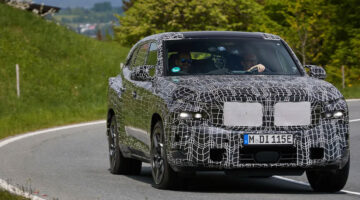BMW’s petrol-electric i8 may be niche, but this new Roadster adds to the model’s appeal.
PRICE: $168,835
| Rating |
 |
|---|
| Pro |
Looks, uniqueness, ev powertrain makes more sense with more range and performance |
| Con |
More a GT car than a sports car, performance more hot hatch |
As BMW’s i8 coupe approaches half a decade on our roads, the Munich firm has given its petrol-electric sports car not only a mid-life facelift, but also increased its electric driving range. Far more obviously, however, it has doubled the number of models in the line-up with the introduction of an i8 Roadster.
This new variant has been created in response to customer demand. BMW’s product planners had never intended for the i8’s carbon tub to be used without a roof, which meant there were a few hurdles to get over before the Roadster could be revealed at the LA motor show at the end of 2017. But the result is an open-top two-seater that loses none of the original coupe’s design impact and increases the appeal of this unique hybrid sports car.
Engine, transmission and 0-100 time
The three-cylinder, 1.5-litre turbocharged petrol engine is untouched in the i8 Roadster, producing the same 228bhp and 236lb ft as it has since the Mini-sourced unit was positioned behind the rear seats and ahead of the rear axle in the original coupe. The six-speed auto remains the same, too, sending drive to the rear wheels.
The battery pack for the front-mounted eDrive electric motor now features denser cells for an increased energy storage capacity (up from 7.1 to 11.6kWh). This permits an increased electric-only driving range – up from 32 to 53 kilometres – as well as the mildest of power hikes for the electric motor – up 12bhp to 141bhp.
When working together, the petrol and electric motors now offer combined power and torque outputs of 369bhp and 420lb ft respectively, resulting in a 0-100kph time of 4.6 seconds (0.2 seconds slower than the coupe) and a limited top speed of 250kph.
Technical highlights
Away from the battery cell improvements (see above), the big technological change to the i8 Roadster is the one made to the car’s structure in turning it from a coupe to a convertible.
With the i8 never originally designed to be an open-top car, BMW’s engineers literally took a saw to an i8 coupe’s roof and cut it off. When the carbon tub didn’t flop around like a teenager with no access to free Wi-Fi, they embarked on a development programme to bring the car to market – not that this was without its challenges.
While the carbon tub retained the vast majority of its rigidity once the roof section had been removed, BMW has still added a plate to the underside of the tub to locate all four-corners as tightly as possible. The A-pillars and windscreen header rail have also been strengthened, but not by inserting steel into their hollow chambers, rather by adding a few additional layers of carbonfibre.
One of the few all-new parts, along with the fabric roof, are the butterfly doors, an item that neither BMW’s customers nor BMW themselves would entertain sacrificing. Therefore, the doors are totally new, primarily to compensate for the lack of window frame, which meant the weight distribution had changed and therefore they wouldn’t stay open, hence also the new hinges.
Without a roof the i8’s aerodynamics were also affected. The initial issue was around the warm air that, on the coupe, escapes through the air-vent in the front bonnet and up and over the car and across the rear deck; with no roof the 70-degree C air would head over the header rail into the laps of the passengers. Therefore, that vent was closed and the air redirected out through the front wheelarches and under the car, causing the i8’s aero performance to be no longer as it needed to be. The engineers suggested a fixed rear spoiler to compensate, to which the designers suggested they think a little harder about the solution. Which they duly did. On went a new rear diffuser, and fixed behind the front bumper ahead of the front wheels is a spoiler-cum-splitter that directs the air accordingly to minimise lift as it travels under the car. A neat solution for a very clever car that still turns heads like few others.

As for the roof, a metal opening roof as per the BMW 4-series was never considered due to the weight, complexity and space requirements. Customers also didn’t want a lift-out targa-style panel, so an electrically operating fabric item was the only consideration. It still robs the i8 of some practicality, however, as the rear seats have been sacrificed to store the roof, but there is an additional 100 litres of luggage space in their place. To prevent the roof material ‘ballooning’ when the hood is up and the car travelling at decent speeds, BMW’s engineers inserted a composite panel at the front of the roof between the layers of fabric.
What’s it like to drive?
Like an i8 coupe but with the option to test some sun cream and hair care products. Actually, there’s more to it than that. The increase in power is masked by the additional 60kg weight penalty the Roadster has over the coupe, but while you don’t get G-inducing forces you do get a much more characterful and engaging experience.
With the roof down the electric motors that is all but mute in the coupe gains a voice – admittedly a bit of a whiny voice, but if you’re a sci-fi fan you’ll probably think you’re an extra in Tron as the sound intensifies as speeds increase. If you’ve ever been to a Formula E race (honestly, give one a go) it’s not far off the noise the single-seaters make when accelerating out of slower corners. Talking of which, another benefit of the larger-capacity battery cells is that the i8 Roadster will now happily drive along under electric power alone at speeds up to 120kph.
With the three-cylinder motor running and the roof open there’s a more melodic beat to the engine that’s absent from the coupe. It’s still no naturally aspirated straight-six, but with the roof open (or the little rear screen retracted) there’s more of a rasp from the exhaust and the now audible chuffs and puffs from the turbocharger add to the soundtrack.
While it may be no quicker than the original i8 coupe, the Roadster does have all-new spring and damper rates, primarily to counter the car’s 60kg weight penalty but also to sharpen the dynamics, which they do to some success. The steering is still too light with a glass-like feel to it, but overall there’s a more detailed and sophisticated approach to its dynamics than before. The front tyres work much harder than before, resisting understeer until much higher speeds; the rear sticks resolutely to its line, too, and only juvenile provocation will unstick it. Not that the i8 Roadster is that kind of car. And still it rides with a serenity and smoothness unexpected of one slung so low.
Roof open, the buffeting is conspicuous by its absence and is no worse than in others cars with a similar open-roof arrangement (think McLaren 570S Spider), and when the roof is closed only an increase in wind noise around the top of the A-pillar can be detected, meaning the i8 remains a great GT-sports car. One that turns heads and leads its class, even though that class still remains a class of one.
Price and rivals
BMW will charge you $168,835 for an i8 Roadster, and it’s a car that has no direct rivals. For a drop-top alternative, therefore, look towards Jaguar’s F-type SVRConvertible at $159,940 or Mercedes-AMG’s GT Roadster at $150,730, both of which offer very different driving experiences from the BMW and have drivetrains that are light years behind the i8’s.
This article originally appeared at evo.co.uk
Copyright © evo UK, Dennis Publishing







